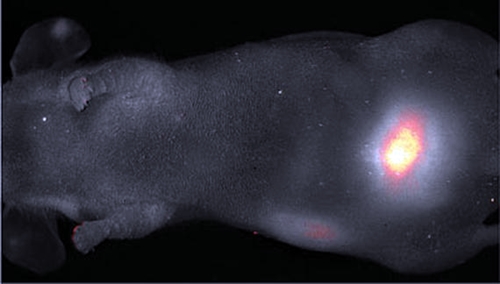
Cornell dots illuminate cells in a lab mouse, in a 2009 preclinical study. (Memorial Sloan Kettering Cancer Center)
1 October 2015. Cornell University and Memorial Sloan Kettering Cancer Center are developing cancer diagnostics and therapies with nanoscale particles, funded largely by a National Cancer Institute grant. NCI, part of National Institutes of Health, is providing $8.2 million to the institutions over five years, while Sloan Kettering is adding $1.9 million.
Cornell and Sloan Kettering are establishing their Center for Translation of Cancer Nanomedicines, with labs on the Cornell campus in Ithaca, New York and at Sloan Kettering in New York City. The center is expected to advance work by both institutions on nanoscale particles called Cornell dots into diagnostic tools and therapies for melanoma, an aggressive form of skin cancer, and malignant brain tumors.
The two institutions are long-time partners on this technology. Cornell dots are silica spheres less than 10 nanometers in diameter that enclose several dye molecules; 1 nanometer is 1 billionth of a meter. The silica shell, essentially glass, is chemically inert and small enough to pass through the body and out in the urine.
For clinical applications, the dots are coated with polyethylene glycol so the body will not recognize them as foreign substances. To make the dots stick to tumor cells, organic molecules that bind to tumor surfaces or specific locations within tumors can be attached to the shell. When exposed to near-infrared light, the dots glow much brighter than the unencapsulated dye, which serves as a beacon to identify the target cells.
As reported in Science & Enterprise, the U.S. Food and Drug Administration in 2011 approved clinical trials of Cornell dots for cancer diagnostics. Last year, Sloan Kettering and Cornell reported first results of an early-stage trial with 5 melanoma patients that found Cornell dots bind to cancer cells at the sites of tumors, as shown by positron emission tomography or PET scans, and cause no toxic or adverse effects.
With the new funding, Sloan Kettering and Cornell plan to focus on further applying the technology to diagnostics and therapies for melanoma and malignant brain cancers. Researchers are expected to develop optical tools to improve detection of cancer sites and treatment planning. Teams also intend to investigate adapting Cornell dots to enhance current cancer therapies.
NCI is funding the project from its Alliance for Nanotechnology in Cancer, under the Centers of Cancer Nanotechnology Excellence program. Uli Wiesner, a materials science and engineering professor at Cornell, and Michelle Bradbury, director of intraoperative imaging at Sloan Kettering, are the principal investigators. Other centers of excellence are being established at Northwestern University, Stanford University, University of North Carolina in Chapel Hill, Washington University in St. Louis, and through a partnership of Cal Tech and UCLA.
Cornell University has patents granted and pending on Cornell dots technology, which are licensed to a start-up company co-founded by Wiesner and Bradbury.
Read more:
- Platelet-Like Nanoparticles Boost Therapeutic Effects
- Grant Funds Research on Nanotech Cancer Treatments
- Magnetic Nanoparticles Found to Boost Immunotherapy
- Patent Awarded for Early, Pre-Symptom Cancer Tests
- System Personalizes Cancer Nanomedicine Treatments
* * *

 RSS - Posts
RSS - Posts
[…] Nanotech Cancer Center Gains $10.1M Funding […]